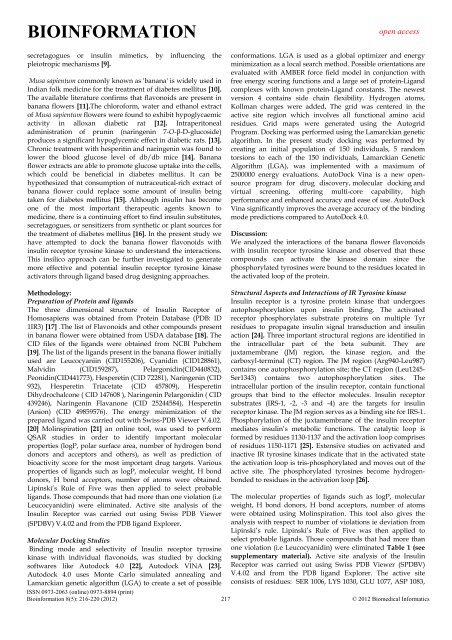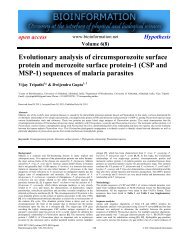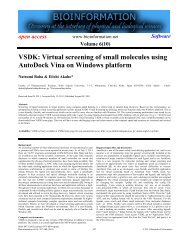Molecular docking studies of banana flower ... - Bioinformation
Molecular docking studies of banana flower ... - Bioinformation
Molecular docking studies of banana flower ... - Bioinformation
You also want an ePaper? Increase the reach of your titles
YUMPU automatically turns print PDFs into web optimized ePapers that Google loves.
BIOINFORMATION<br />
secretagogues or insulin mimetics, by influencing the<br />
pleiotropic mechanisms [9].<br />
Musa sapientum commonly known as '<strong>banana</strong>' is widely used in<br />
Indian folk medicine for the treatment <strong>of</strong> diabetes mellitus [10].<br />
The available literature confirms that flavonoids are present in<br />
<strong>banana</strong> <strong>flower</strong>s [11].The chlor<strong>of</strong>orm, water and ethanol extract<br />
<strong>of</strong> Musa sapientum <strong>flower</strong>s were found to exhibit hypoglycaemic<br />
activity in alloxan diabetic rat [12]. Intraperitoneal<br />
administration <strong>of</strong> prunin (naringenin 7-O-β-D-glucoside)<br />
produces a significant hypoglycemic effect in diabetic rats. [13].<br />
Chronic treatment with hesperitin and naringenin was found to<br />
lower the blood glucose level <strong>of</strong> db/db mice [14]. Banana<br />
<strong>flower</strong> extracts are able to promote glucose uptake into the cells,<br />
which could be beneficial in diabetes mellitus. It can be<br />
hypothesized that consumption <strong>of</strong> nutraceutical-rich extract <strong>of</strong><br />
<strong>banana</strong> <strong>flower</strong> could replace some amount <strong>of</strong> insulin being<br />
taken for diabetes mellitus [15]. Although insulin has become<br />
one <strong>of</strong> the most important therapeutic agents known to<br />
medicine, there is a continuing effort to find insulin substitutes,<br />
secretagogues, or sensitizers from synthetic or plant sources for<br />
the treatment <strong>of</strong> diabetes mellitus [16]. In the present study we<br />
have attempted to dock the <strong>banana</strong> <strong>flower</strong> flavonoids with<br />
insulin receptor tyrosine kinase to understand the interactions.<br />
This insilico approach can be further investigated to generate<br />
more effective and potential insulin receptor tyrosine kinase<br />
activators through ligand based drug designing approaches.<br />
Methodology:<br />
Preparation <strong>of</strong> Protein and ligands<br />
The three dimensional structure <strong>of</strong> Insulin Receptor <strong>of</strong><br />
Homosapiens was obtained from Protein Database (PDB: ID<br />
1IR3) [17] .The list <strong>of</strong> Flavonoids and other compounds present<br />
in <strong>banana</strong> <strong>flower</strong> were obtained from USDA database [18]. The<br />
CID files <strong>of</strong> the ligands were obtained from NCBI Pubchem<br />
[19]. The list <strong>of</strong> the ligands present in the <strong>banana</strong> <strong>flower</strong> initially<br />
used are Leucocyaniin (CID155206), Cyanidin (CID128861),<br />
Malvidin (CID159287), Pelargonidin(CID440832),<br />
Peonidin(CID441773), Hesperetin (CID 72281), Naringenin (CID<br />
932), Hesperetin Triacetate (CID 457809), Hesperetin<br />
Dihydrochalcone ( CID 147608 ), Naringenin Pelargonidin ( CID<br />
439246), Naringenin Flavanone (CID 25244584), Hesperetin<br />
(Anion) (CID 49859576). The energy minimization <strong>of</strong> the<br />
prepared ligand was carried out with Swiss-PDB Viewer V.4.02.<br />
[20] Molinspiration [21] an online tool, was used to perform<br />
QSAR <strong>studies</strong> in order to identify important molecular<br />
properties (logP, polar surface area, number <strong>of</strong> hydrogen bond<br />
donors and acceptors and others), as well as prediction <strong>of</strong><br />
bioactivity score for the most important drug targets. Various<br />
properties <strong>of</strong> ligands such as logP, molecular weight, H bond<br />
donors, H bond acceptors, number <strong>of</strong> atoms were obtained.<br />
Lipinski’s Rule <strong>of</strong> Five was then applied to select probable<br />
ligands. Those compounds that had more than one violation (i.e<br />
Leucocyanidin) were eliminated. Active site analysis <strong>of</strong> the<br />
Insulin Receptor was carried out using Swiss PDB Viewer<br />
(SPDBV) V.4.02 and from the PDB ligand Explorer.<br />
<strong>Molecular</strong> Docking Studies<br />
Binding mode and selectivity <strong>of</strong> Insulin receptor tyrosine<br />
kinase with individual flavonoids, was studied by <strong>docking</strong><br />
s<strong>of</strong>twares like Autodock 4.0 [22], Autodock VINA [23].<br />
Autodock 4.0 uses Monte Carlo simulated annealing and<br />
Lamarckian genetic algorithm (LGA) to create a set <strong>of</strong> possible<br />
open access<br />
conformations. LGA is used as a global optimizer and energy<br />
minimization as a local search method. Possible orientations are<br />
evaluated with AMBER force field model in conjunction with<br />
free energy scoring functions and a large set <strong>of</strong> protein-Ligand<br />
complexes with known protein-Ligand constants. The newest<br />
version 4 contains side chain flexibility. Hydrogen atoms,<br />
Kollman charges were added. The grid was centered in the<br />
active site region which involves all functional amino acid<br />
residues. Grid maps were generated using the Autogrid<br />
Program. Docking was performed using the Lamarckian genetic<br />
algorithm. In the present study <strong>docking</strong> was performed by<br />
creating an initial population <strong>of</strong> 150 individuals, 5 random<br />
torsions to each <strong>of</strong> the 150 individuals, Lamarckian Genetic<br />
Algorithm (LGA), was implemented with a maximum <strong>of</strong><br />
2500000 energy evaluations. AutoDock Vina is a new opensource<br />
program for drug discovery, molecular <strong>docking</strong> and<br />
virtual screening, <strong>of</strong>fering multi-core capability, high<br />
performance and enhanced accuracy and ease <strong>of</strong> use. AutoDock<br />
Vina significantly improves the average accuracy <strong>of</strong> the binding<br />
mode predictions compared to AutoDock 4.0.<br />
Discussion:<br />
We analyzed the interactions <strong>of</strong> the <strong>banana</strong> <strong>flower</strong> flavonoids<br />
with insulin receptor tyrosine kinase and observed that these<br />
compounds can activate the kinase domain since the<br />
phosphorylated tyrosines were bound to the residues located in<br />
the activated loop <strong>of</strong> the protein.<br />
Structural Aspects and Interactions <strong>of</strong> IR Tyrosine kinase<br />
Insulin receptor is a tyrosine protein kinase that undergoes<br />
autophosphorylation upon insulin binding. The activated<br />
receptor phosphorylates substrate proteins on multiple Tyr<br />
residues to propagate insulin signal transduction and insulin<br />
action [24]. Three important structural regions are identified in<br />
the intracellular part <strong>of</strong> the beta subunit. They are<br />
juxtamembrane (JM) region, the kinase region, and the<br />
carboxyl-terminal (CT) region. The JM region (Arg940-Leu987)<br />
contains one autophosphorylation site; the CT region (Leu1245-<br />
Ser1343) contains two autophosphorylation sites. The<br />
intracellular portion <strong>of</strong> the insulin receptor, contain functional<br />
groups that bind to the effector molecules. Insulin receptor<br />
substrates (IRS-1, -2, -3 and -4) are the targets for insulin<br />
receptor kinase. The JM region serves as a binding site for IRS-1.<br />
Phosphorylation <strong>of</strong> the juxtamembrane <strong>of</strong> the insulin receptor<br />
mediates insulin’s metabolic functions. The catalytic loop is<br />
formed by residues 1130-1137 and the activation loop comprises<br />
<strong>of</strong> residues 1150-1171 [25]. Extensive <strong>studies</strong> on activated and<br />
inactive IR tyrosine kinases indicate that in the activated state<br />
the activation loop is tris-phosphorylated and moves out <strong>of</strong> the<br />
active site. The phosphorylated tyrosines become hydrogenbonded<br />
to residues in the activation loop [26].<br />
The molecular properties <strong>of</strong> ligands such as logP, molecular<br />
weight, H bond donors, H bond acceptors, number <strong>of</strong> atoms<br />
were obtained using Molinspiration. This tool also gives the<br />
analysis with respect to number <strong>of</strong> violations ie deviation from<br />
Lipinski’s rule. Lipinski’s Rule <strong>of</strong> Five was then applied to<br />
select probable ligands. Those compounds that had more than<br />
one violation (i.e Leucocyanidin) were eliminated Table 1 (see<br />
supplementary material). Active site analysis <strong>of</strong> the Insulin<br />
Receptor was carried out using Swiss PDB Viewer (SPDBV)<br />
V.4.02 and from the PDB ligand Explorer. The active site<br />
consists <strong>of</strong> residues: SER 1006, LYS 1030, GLU 1077, ASP 1083,<br />
ISSN 0973-2063 (online) 0973-8894 (print)<br />
<strong>Bioinformation</strong> 8(5): 216-220 (2012) 217 © 2012 Biomedical Informatics







